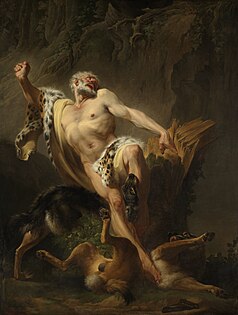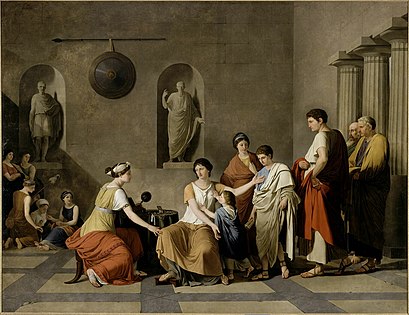Joseph-Benoît Suvée
- Machine translation, like DeepL or Google Translate, is a useful starting point for translations, but translators must revise errors as necessary and confirm that the translation is accurate, rather than simply copy-pasting machine-translated text into the English Wikipedia.
- Do not translate text that appears unreliable or low-quality. If possible, verify the text with references provided in the foreign-language article.
- You must provide copyright attribution in the edit summary accompanying your translation by providing an interlanguage link to the source of your translation. A model attribution edit summary is
Content in this edit is translated from the existing French Wikipedia article at [[:fr:Joseph-Benoît Suvée]]; see its history for attribution. - You may also add the template
{{Translated|fr|Joseph-Benoît Suvée}}to the talk page. - For more guidance, see Wikipedia:Translation.
Joseph-Benoît Suvée | |
|---|---|
 Self-portrait (1771) | |
| Born | 3 January 1743 Bruges |
| Died | 9 February 1807(1807-02-09) (aged 64) Rome |
| Nationality | Belgian |
| Education | Pupil of Matthias de Visch and Jean-Jacques Bachelier |
| Known for | Painting |
| Notable work | Cornelia, Mother of the Gracchi (1795) |
| Movement | Neo-classicism |
| Awards | Prix de Rome (1771) |
Joseph-Benoît Suvée (3 January 1743 – 9 February 1807) was a Flemish painter strongly influenced by French neo-classicism.
Biography
Suvée was born in Bruges. Initially a pupil of Matthias de Visch, he came to France aged 19 and became a pupil of Jean-Jacques Bachelier. In 1771, he won the Prix de Rome. In Rome from 1772 to 1778, he prolonged the usual duration allowed to pensionaries of the French Academy in Rome. He was named an academician on his return to Paris and he opened an art school for young women at the Louvre. One of his students was Constance Mayer. He emulated and competed with Jacques-Louis David, earning his enduring hatred.
Named the French Academy in Rome's director in 1792, replacing François-Guillaume Ménageot, he was imprisoned for a while in the Prison Saint-Lazare and only able to take up the post in 1801. After a brilliant career, and a six years' stay in Rome as the Academy's Director, he died there suddenly.
His works include Achilles depositing the body of Hector at the feet of the body of Patroclus, (1769, Louvre), and Cornelia, mother of the Gracchi, (1795, Louvre).
His pupils were Jean-Baptiste Joseph Autrique (1777–1853), Augustin van den Berghe, Marie Bouliard, Cornelis Cels, Césarine Henriette Flore Davin, Joseph-François Ducq, Jean-Bernard Duvivier, Guillielmus Petrus Geysen (1761–1827), Albert Gregorius, Jean-François Legillon, Constance Mayer, Jozef Karel De Meulemeester (1774–1836), Joseph Denis Odevaere, Gertrude de Pélichy, Pierre Joseph Petit (1768–1825), Ange René Ravault (1766–1845), Jacques-Albert Senave, Charles Spruyt (1769–1851), Philip van der Wal (1774–?), and François Wynckelman [nl].[1] Anna Barbara Bansi, with whom he is said to have had an affair,[2] was another pupil.[3]
Selected paintings
-
 The Predication of
The Predication of
Saint Paul -

-
-
 Erminia and the Shepherds
Erminia and the Shepherds
References
External links

- Works by Suvée at the Louvre
- Graphic works of Suvée in the Flemish Art Collection
- v
- t
- e
- Charles Errard (1666)
- Noël Coypel (1673)
- Charles Errard (1675)
- Matthieu de La Teulière (1684)
- René-Antoine Houasse (1699)
- Charles-François Poerson (1704)
- Nicolas Vleughels (1725)
- Pierre de l’Estache (1737)
- Jean François de Troy (1738)
- Charles-Joseph Natoire (1751)
- Noël Hallé (1775)
- Joseph-Marie Vien (1775)
- Louis-Jean-François Lagrenée (1781)
- François-Guillaume Ménageot (1787)
- Joseph-Benoît Suvée (1792)
- Pierre-Adrien Pâris (1807)
- Guillaume Guillon-Lethière (1807)
- Charles Thévenin (1816)
- Pierre-Narcisse Guérin (1823)
- Horace Vernet (1829)
- Jean-Auguste-Dominique Ingres (1835)
- Jean-Victor Schnetz (1841)
- Jean Alaux (1847)
- Jean-Victor Schnetz (1853)
- Joseph-Nicolas Robert-Fleury (1866)
- Ernest Hébert (1867)
- Jules Eugène Lenepveu (1873)
- Louis-Nicolas Cabat (1879)
- Ernest Hébert (1885)
- Eugène Guillaume (1891)
- Carolus-Duran (1905)
- Paul-Albert Besnard (1913)
- Denys Puech (1921)
- Paul-Maximilien Landowski (1933)
- Jacques Ibert (1937)
- Balthus (1961)
- Jean Leymarie (1977)
- Jean-Marie Drot (1985)
- Pierre-Jean Angremy (1994)
- Bruno Racine (1997)
- Richard Peduzzi (2002)
- Frédéric Mitterrand (2008)
- Éric de Chassey (2009)
















